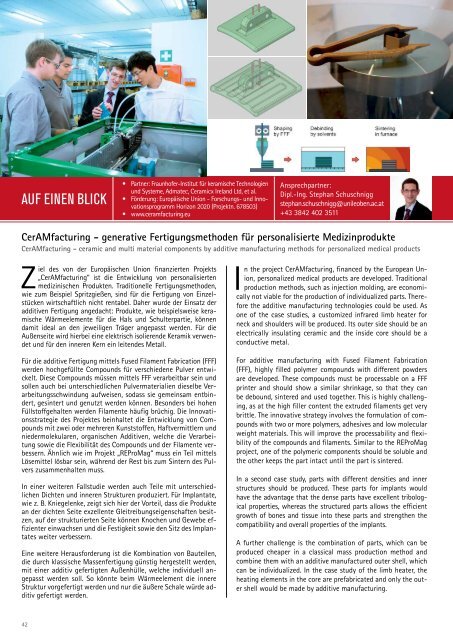Kunststofftechnik Leoben - Zweijahresbericht 2015 - 2016
Sie wollen auch ein ePaper? Erhöhen Sie die Reichweite Ihrer Titel.
YUMPU macht aus Druck-PDFs automatisch weboptimierte ePaper, die Google liebt.
AUF EINEN BLICK<br />
• Partner: Fraunhofer-Institut für keramische Technologien<br />
und Systeme, Admatec, Ceramicx Ireland Ltd, et al.<br />
• Förderung: Europäische Union - Forschungs- und Innovationsprogramm<br />
Horizon 2020 (Projektn. 678503)<br />
• www.ceramfacturing.eu<br />
Ansprechpartner:<br />
Dipl.-Ing. Stephan Schuschnigg<br />
stephan.schuschnigg@unileoben.ac.at<br />
+43 3842 402 3511<br />
CerAMfacturing - generative Fertigungsmethoden für personalisierte Medizinprodukte<br />
CerAMfacturing - ceramic and multi material components by additive manufacturing methods for personalized medical products<br />
Ziel des von der Europäischen Union finanzierten Projekts<br />
„CerAMfacturing“ ist die Entwicklung von personalisierten<br />
medizinischen Produkten. Traditionelle Fertigungsmethoden,<br />
wie zum Beispiel Spritzgießen, sind für die Fertigung von Einzelstücken<br />
wirtschaftlich nicht rentabel. Daher wurde der Einsatz der<br />
additiven Fertigung angedacht: Produkte, wie beispielsweise keramische<br />
Wärmeelemente für die Hals und Schulterpartie, können<br />
damit ideal an den jeweiligen Träger angepasst werden. Für die<br />
Außenseite wird hierbei eine elektrisch isolierende Keramik verwendet<br />
und für den inneren Kern ein leitendes Metall.<br />
Für die additive Fertigung mittels Fused Filament Fabrication (FFF)<br />
werden hochgefüllte Compounds für verschiedene Pulver entwickelt.<br />
Diese Compounds müssen mittels FFF verarbeitbar sein und<br />
sollen auch bei unterschiedlichen Pulvermaterialien dieselbe Verarbeitungsschwindung<br />
aufweisen, sodass sie gemeinsam entbindert,<br />
gesintert und genutzt werden können. Besonders bei hohen<br />
Füllstoffgehalten werden Filamente häufig brüchig. Die Innovationsstrategie<br />
des Projektes beinhaltet die Entwicklung von Compounds<br />
mit zwei oder mehreren Kunststoffen, Haftvermittlern und<br />
niedermolekularen, organischen Additiven, welche die Verarbeitung<br />
sowie die Flexibilität des Compounds und der Filamente verbessern.<br />
Ähnlich wie im Projekt „REProMag“ muss ein Teil mittels<br />
Lösemittel lösbar sein, während der Rest bis zum Sintern des Pulvers<br />
zusammenhalten muss.<br />
In einer weiteren Fallstudie werden auch Teile mit unterschiedlichen<br />
Dichten und inneren Strukturen produziert. Für Implantate,<br />
wie z. B. Kniegelenke, zeigt sich hier der Vorteil, dass die Produkte<br />
an der dichten Seite exzellente Gleitreibungseigenschaften besitzen,<br />
auf der strukturierten Seite können Knochen und Gewebe effizienter<br />
einwachsen und die Festigkeit sowie den Sitz des Implantates<br />
weiter verbessern.<br />
Eine weitere Herausforderung ist die Kombination von Bauteilen,<br />
die durch klassische Massenfertigung günstig hergestellt werden,<br />
mit einer additiv gefertigten Außenhülle, welche individuell angepasst<br />
werden soll. So könnte beim Wärmeelement die innere<br />
Struktur vorgefertigt werden und nur die äußere Schale würde additiv<br />
gefertigt werden.<br />
In the project CerAMfacturing, financed by the European Union,<br />
personalized medical products are developed. Traditional<br />
production methods, such as injection molding, are economically<br />
not viable for the production of individualized parts. Therefore<br />
the additive manufacturing technologies could be used. As<br />
one of the case studies, a customized infrared limb heater for<br />
neck and shoulders will be produced. Its outer side should be an<br />
electrically insulating ceramic and the inside core should be a<br />
conductive metal.<br />
For additive manufacturing with Fused Filament Fabrication<br />
(FFF), highly filled polymer compounds with different powders<br />
are developed. These compounds must be processable on a FFF<br />
printer and should show a similar shrinkage, so that they can<br />
be debound, sintered and used together. This is highly challenging,<br />
as at the high filler content the extruded filaments get very<br />
brittle. The innovative strategy involves the formulation of compounds<br />
with two or more polymers, adhesives and low molecular<br />
weight materials. This will improve the processability and flexibility<br />
of the compounds and filaments. Similar to the REProMag<br />
project, one of the polymeric components should be soluble and<br />
the other keeps the part intact until the part is sintered.<br />
In a second case study, parts with different densities and inner<br />
structures should be produced. These parts for implants would<br />
have the advantage that the dense parts have excellent tribological<br />
properties, whereas the structured parts allows the efficient<br />
growth of bones and tissue into these parts and strengthen the<br />
compatibility and overall properties of the implants.<br />
A further challenge is the combination of parts, which can be<br />
produced cheaper in a classical mass production method and<br />
combine them with an additive manufactured outer shell, which<br />
can be individualized. In the case study of the limb heater, the<br />
heating elements in the core are prefabricated and only the outer<br />
shell would be made by additive manufacturing.<br />
42


